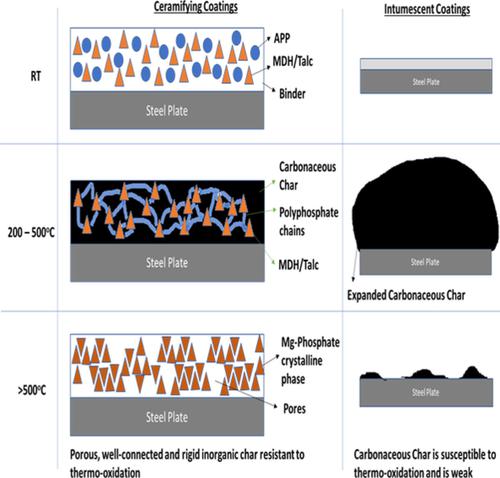当前位置:
X-MOL 学术
›
J. Appl. Polym. Sci.
›
论文详情
Our official English website, www.x-mol.net, welcomes your
feedback! (Note: you will need to create a separate account there.)
Acrylic‐based fire‐retardant coatings for steel protection: Employing the concept of in situ ceramization
Journal of Applied Polymer Science ( IF 2.7 ) Pub Date : 2020-11-21 , DOI: 10.1002/app.50299 Sheik Mohamed Anees 1 , Aravind Dasari 1
Journal of Applied Polymer Science ( IF 2.7 ) Pub Date : 2020-11-21 , DOI: 10.1002/app.50299 Sheik Mohamed Anees 1 , Aravind Dasari 1
Affiliation

|
Traditional intumescent coatings are widely used as passive fire‐protective coatings for steel structures as they are capable of expanding in the range of 20–50 times the original thickness thereby providing excellent insulation. However, the fragile nature of such residue and susceptibility to thermo‐oxidation given their carbonaceous nature are key problematic issues. The concept of in situ ceramization is explored in this work as a means to form inorganic cohesive char with improved rigidity and thermo‐oxidative stability. Coating samples were prepared by incorporating ammonium polyphosphate, talc, Mg(OH)2, and polydimethylsiloxane as additives into acrylic resin at different weight fractions. Thermal analysis and x‐ray diffraction have confirmed the reactions between the additives to form various crystalline magnesium phosphate phases, and to a small extent, silicon phosphate, thereby ensuring the thermo‐oxidative stability of the residue. This is reiterated by the fire performance tests (by exposing the coatings to a temperature profile in a furnace similar to ISO 834 fire curve). Despite the advantages of rigid char and its thermo‐oxidative stability as a result of formation of inorganic phosphates, the lack of swelling has resulted in relatively poor insulation capabilities of the char, and subsequently, compromised the fire protection times (that are in the range of 45–55 min). However, pyrolysis flow combustion calorimeter results of the coatings are promising and have shown a significant drop of up to 70% in the peak of heat release rate values as compared to neat resin.
中文翻译:

用于钢保护的丙烯酸基防火涂料:采用原位陶瓷化的概念
传统的膨胀型涂料被广泛用作钢结构的被动防火涂料,因为它们能够在原始厚度的20–50倍范围内膨胀,从而提供出色的绝缘性。但是,此类残渣的易碎性质和碳质性质使其易于受到热氧化,这是关键的问题。在这项工作中探索了原位陶瓷化的概念,作为形成具有更高刚性和热氧化稳定性的无机粘结炭的一种手段。通过掺入多磷酸铵,滑石粉,Mg(OH)2制备涂层样品和聚二甲基硅氧烷作为添加剂以不同的重量分数加入丙烯酸树脂中。热分析和X射线衍射证实了添加剂之间的反应以形成各种结晶的磷酸镁相,并在较小程度上形成了磷酸硅,从而确保了残留物的热氧化稳定性。防火性能测试(通过将涂层暴露在类似于ISO 834防火曲线的熔炉中的温度曲线中)重申了这一点。尽管由于形成了无机磷酸盐而具有硬质炭及其热氧化稳定性的优点,但膨胀不足导致炭的隔热性能相对较差,继而损害了防火时间(在此范围内)。 45-55分钟)。然而,
更新日期:2020-11-21
中文翻译:

用于钢保护的丙烯酸基防火涂料:采用原位陶瓷化的概念
传统的膨胀型涂料被广泛用作钢结构的被动防火涂料,因为它们能够在原始厚度的20–50倍范围内膨胀,从而提供出色的绝缘性。但是,此类残渣的易碎性质和碳质性质使其易于受到热氧化,这是关键的问题。在这项工作中探索了原位陶瓷化的概念,作为形成具有更高刚性和热氧化稳定性的无机粘结炭的一种手段。通过掺入多磷酸铵,滑石粉,Mg(OH)2制备涂层样品和聚二甲基硅氧烷作为添加剂以不同的重量分数加入丙烯酸树脂中。热分析和X射线衍射证实了添加剂之间的反应以形成各种结晶的磷酸镁相,并在较小程度上形成了磷酸硅,从而确保了残留物的热氧化稳定性。防火性能测试(通过将涂层暴露在类似于ISO 834防火曲线的熔炉中的温度曲线中)重申了这一点。尽管由于形成了无机磷酸盐而具有硬质炭及其热氧化稳定性的优点,但膨胀不足导致炭的隔热性能相对较差,继而损害了防火时间(在此范围内)。 45-55分钟)。然而,











































 京公网安备 11010802027423号
京公网安备 11010802027423号